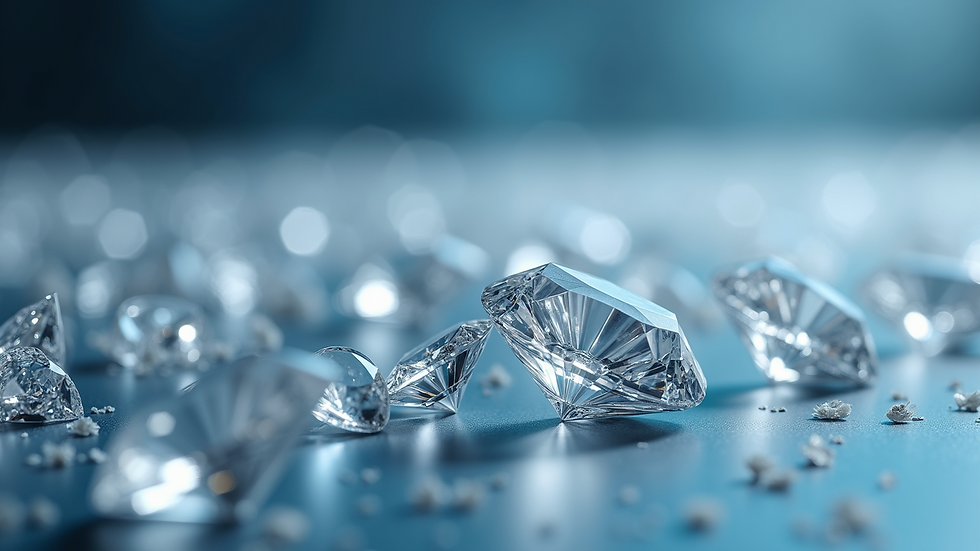How Sustainable Practices Are Changing the Jewelry Industry
- Mode Royale Luxury Brand
- Jun 4
- 4 min read
The jewelry industry is undergoing a significant transformation, driven by a growing awareness of environmental issues and a demand for ethical practices. Consumers are increasingly seeking pieces that reflect their values, pushing brands to adopt sustainable practices. From sourcing materials responsibly to reducing waste, sustainable jewelry is reshaping the industry in profound ways.
What is Sustainable Jewelry?
Sustainable jewelry refers to pieces crafted with consideration for environmental impact and social responsibility. This includes using recycled materials, ethically sourced gems, and sustainable manufacturing processes. According to a report by ResearchAndMarkets.com, the global ethical jewelry market is projected to reach $32.41 billion by 2025, reflecting a surge in consumer interest.
Moreover, sustainable jewelry often includes a focus on transparency. Consumers want to know where their materials come from and how their items are produced. This shift toward sustainability is compelling brands to rethink their practices at every level.

The Rise of Ethical Sourcing
One of the most pressing issues in the jewelry industry has been the sourcing of raw materials. Traditionally, mining for diamonds, gold, and other precious materials has raised ethical concerns regarding labor, environmental destruction, and conflict finance. However, sustainable practices are changing this narrative.
Brands are increasingly turning to recycled metals and lab-grown diamonds, which offer ethical alternatives that reduce the environmental footprint. For instance, lab-grown diamonds create far less waste and require significantly less water compared to traditional diamond mining. A 2020 study by the University of Colorado Boulder indicated that lab-grown diamonds produce 94 percent less carbon dioxide than mined diamonds.
Additionally, organizations like the Responsible Jewelry Council are helping ensure that companies adhere to strict ethical sourcing guidelines. The implementation of blockchain technology has also allowed consumers to trace the origins of their jewelry, providing peace of mind in their purchases.

Reducing Waste and Embracing Upcycling
Waste reduction is another crucial aspect of sustainability in the jewelry industry. Many jewelry brands now embrace upcycling, transforming old or discarded pieces into new jewelry. This practice not only reduces waste but also tells a unique story through each piece created.
For example, brands like Brilliant Earth are pioneering upcycled jewelry collections that breathe new life into vintage pieces. Upcycling can become an art form, allowing jewelers to create one-of-a-kind designs that showcase the beauty of repurposed materials. By incorporating discarded or vintage materials, companies can also contribute to a circular economy, where products are reused and recycled rather than thrown away.
Practical Tips for Sustainable Jewelry Shopping
As a consumer, you can make informed decisions that support sustainable practices in the jewelry industry. Here are several actionable tips to consider:
Research the Brand: Look for companies that clearly explain their sourcing and manufacturing processes. Transparency is key; trustworthy brands will openly discuss their practices.
Seek Certifications: Look for certifications from recognized organizations that focus on ethical practices and standards, such as the Responsible Jewelry Council or Fair Trade.
Opt for Lab-Grown or Recycled: Consider purchasing lab-grown diamonds or jewelry made from recycled materials. These options are often more sustainable and, in many cases, more affordable.
Buy Vintage or Second-Hand: Vintage jewelry carries history and character. By purchasing second-hand pieces, you are also supporting a more sustainable practice by extending the lifecycle of existing products.
Consider Custom Pieces: If possible, invest in a custom charm necklace designed specifically for you. Custom pieces can often incorporate recycled materials and provide you with a unique statement without contributing to mass production.

The Impact of Consumer Awareness
The increased focus on sustainable practices in the jewelry industry has been largely driven by consumer awareness. Social media platforms like Instagram and Pinterest have amplified voices advocating for ethical practices, allowing consumers to educate themselves and connect with brands that align with their values.
Furthermore, environmental documentaries, articles, and awareness campaigns have brought attention to pressing issues such as “blood diamonds” and harmful mining practices. Consumers are now demanding more from jewelry brands, pushing them to not only adopt sustainable practices but also engage with communities and contribute to social causes.
The Future of Sustainable Jewelry
The jewelry industry appears to be on a promising path toward sustainability, but challenges remain. The integration of sustainable practices requires consistent effort, innovation, and commitment from brands. As new materials and technologies are developed, the potential for sustainable jewelry becomes even greater.
Emerging technologies like 3D printing and AI are being explored for creating jewelry more efficiently and with less waste. Additionally, as consumer education continues to grow, brands will need to keep pace with emerging trends and expectations.
The movement toward sustainable practices is more than just a trend; it reflects a broader awareness of our consumption habits and their impact on the planet. The future will see more brands embracing green initiatives and prioritizing ethical practices.
In summary, the integration of sustainability into the jewelry industry represents a powerful shift toward more responsible consumption. Whether you seek a minimalistic design or a uniquely crafted custom charm necklace, you’re now empowered to make choices that align with your values.
Embrace Sustainable Choices in Jewelry
Choosing sustainable jewelry is not just about fashion; it’s about making a statement that concerns the future of our planet. Every piece of jewelry tells a story, and by selecting ethically sourced or upcycled materials, you contribute to a narrative of responsibility and care.
As the jewelry industry continues to change, embrace the opportunity to be a part of this positive evolution. Whether you’re purchasing for yourself or gifting a loved one, your choice can reflect hope for a sustainable future in the world of fashion.





Comments